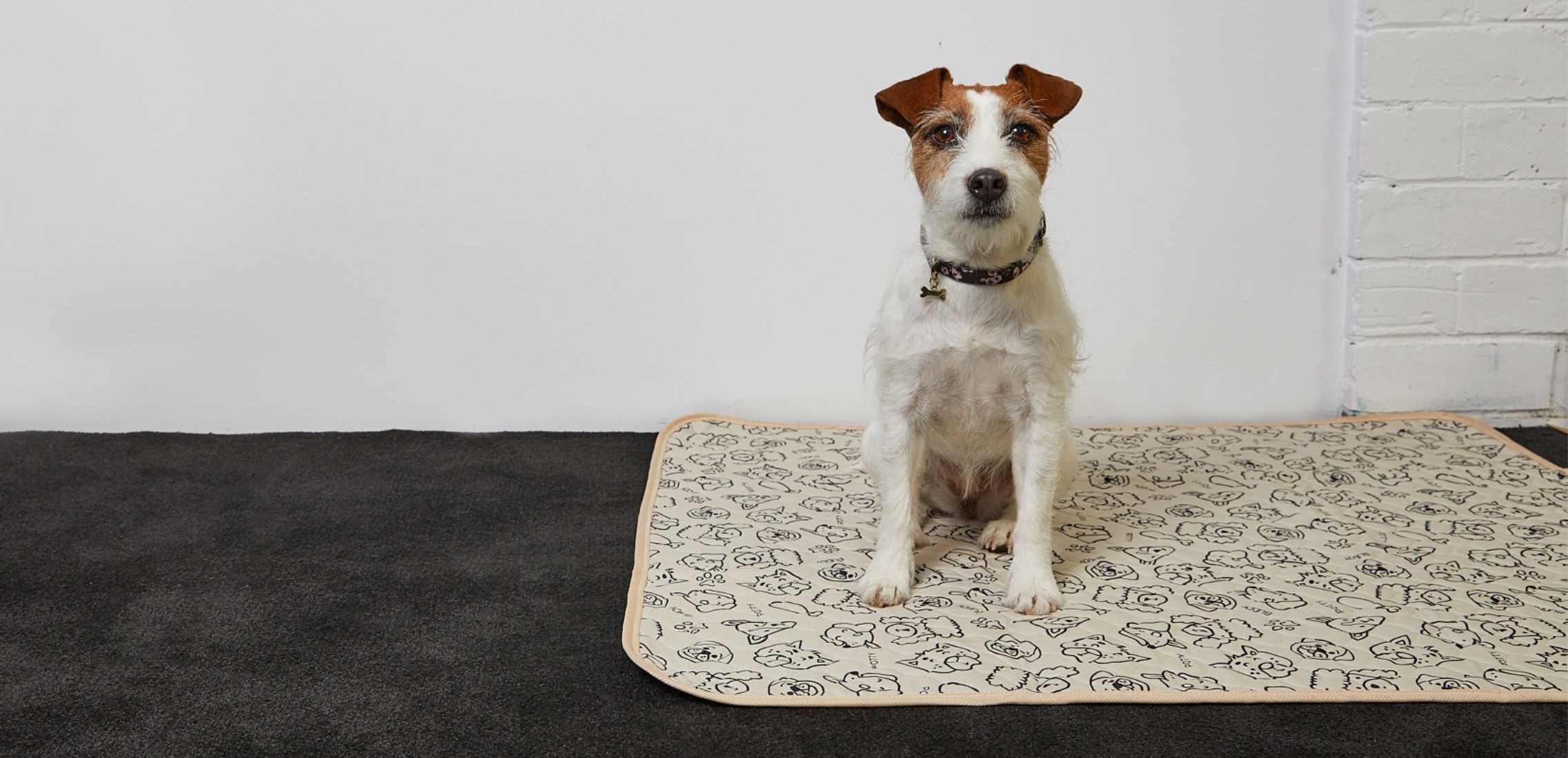Your Cart is Empty
🎉End of Year Sale | Up to 40% OFF
🎉End of Year Sale | Up to 40% OFF
🎉End of Year Sale | Up to 40% OFF

Potty training can be a tricky business. It requires a great deal of patience and a few near misses before your pup fully grasps this house pet business!
That’s why pee pads are a firm favorite of puppy parents to keep their floors pee-free, whilst offering a safe space and routine for dogs to learn when and where they can go to the toilet.
So, you’ve got the pads all set up, but when your pup goes to tinkle they tend to pee NEXT to the pad as opposed to on it.
But why does my dog pee off the pad? Is it anything to worry about? And how can I stop it before it becomes a habit?
In this blog we will look at the reasons why a puppy might pee next to his pad and what you as a dog owner can do to support them in peeing with precision.
Dogs can only communicate through behavior; they don’t speak people and we don’t speak dog, so we have to rely on their actions to tell us how they are feeling.
If your dog is peeing next to the pad, it could be they are trying to tell you one of the following:

If a dog pees next to their pad it could be because they don’t actually know what it’s for. Suddenly being faced with a large pee pad if they’ve never seen one before can be a little confronting for your pup, and they may not realize its purpose.
It is only through training, repetition, patience and encouragement from their person that a dog will learn how to use their pad.
Younger dogs especially may think that their pee pad is a toy. It is not uncommon for puppies to chew, scratch and drag their pee pad around at first, and so will avoid using the pad for its proper purpose, resulting in pee puddles where they shouldn’t be.
If you notice your puppy treating their pee pad as a toy, try to correct this association by redirecting their playful energy to their actual toys - whilst encouraging them to only interact with their pee pad during toilet time.


As humans, we wouldn’t want to go to the toilet next to where we eat and sleep, and dogs are no different.
If a pee pad is placed too close to their bed, food or water source, it may deter them from using the pad properly, and so they will do everything they can to pee as far away from it as they can.
If the pad isn’t in an easy access area, your dog may then decide to pee - or get caught short! - near the pad instead.
For example, some areas that may be difficult to reach include: areas with lots of other furniture or distractions, areas that are gated off, areas where other animals may be present, areas that are too far away from where they usually hang out and areas that they have to climb to reach.


If you’re finding that your dog pees off the pee pad, it could be because they are either confused or overwhelmed. If their pads are not kept in the same place, especially if they are new to the house or environment, this can lead to confusion and accidents.
Like most of us, dogs also appreciate a little calm and privacy when using the toilet. And so if you place their pads in high-traffic areas with lots of people and noise, it could make them anxious, resulting in an avoidance of using the pads.
Sometimes, a pee puddle is just down to a lack of aim! Particularly common in male dogs, younger dogs especially may need some guidance to ensure they are aiming in the right direction. Encouraging your dog to pee closer to the center of the pad will help reduce the risk of spills.
It’s important not to punish or admonish your puppy if they miss-aim and pee beside their pad, rather than on it. Instead, focus on using positive reinforcement and use gentle recorrections so that they learn where “to” and “not to” go.


If a dog pees next to their pad, it could be down to the simple issue that the pad needs cleaning. A dog will be deterred from using their pad if it has been used too many times and needs changing. Pop your Potty Buddy Reusable pee pad in the wash to keep your pup peeing in peace!
(Seriously, all it takes is a short wash and you can get your reusable pee pad into tip top shape once again.)
Puppies are not able to hold their pee for as long as adult dogs, and so sometimes they simply don’t make it to the pad in time. It is advised to create a regular toilet schedule for puppies, placing them on the pad every hour or so to encourage them to relieve themselves.
If you would like guidance on a proper toilet schedule for puppies and how often you should be encouraging your dog to go toilet, check out our blog on How Long Can Dogs Hold Their Pee? here.

As soon as you notice that your dog is peeing off their pad, it’s important to step in straight away to stop it becoming a bad habit. The quicker you nip this unwanted behavior in the bud, the sooner you create a better routine for both owner and dog.
Why not check out our previous blog on how to train your puppy to use a puppy pad, where we go through all the tips and tricks for toilet training your pooch.
In the meantime, here are some of the potty training basics for using dog pee pads:

It’s important that you follow the 3 Ps of potty training your dog using a pee pad: Positive, Proactive and Patience.
Firstly, approaching this training with a positive mindset will be much more constructive than allowing yourself to get frustrated quickly.
Secondly, it’s about being proactive in your puppy’s training - ensuring you consistently send them the same signals and providing them with the structure to thrive.
And thirdly, it’s about being patient and understanding that training takes time and won’t happen overnight.
To avoid confusion and near-misses for your pup, make sure you choose an easily accessible place for your pee pads and keep them there, giving your dog clear spaces to do their business without stress.
Encouraging your dog to pee in the middle of the pee pad will minimize aim issues and avoid leaks.
Why not try giving your pup a little treat each time they manage to use the middle of the pee pad? This will give them an incentive to repeat the desired behavior.


Putting down too many pads can just end up being overwhelming for your dog. Place no more than 2-3 pee pads at a time around the house, giving your dog options and ease whilst not confusing them.
Keeping your dog’s pee pads clean reduces odor and bacteria build up and makes it more comfortable for your dog to use, creating a clean and sanitary environment for both dog and owner.
At the end of the day, potty training will come with its ups and downs. However keeping pee pads clean and easy to access, whilst implementing a regular toilet routine for your dog will all contribute to a successful outcome.
Follow our top tips for ensuring your puppy actually pees on their reusable potty pad, and you’ll be well on your way to potty training success.
As we mentioned before, it’s about being positive, proactive, consistent and patient. Never resort to physical punishment or admonishment of your dog - as remember they’re still young and learning, and definitely not doing it on purpose to annoy you!
We have heaps of additional information on our blog, so make sure to dive into our other articles for further help in supporting your pup’s potty hygiene.
See How Dog Owners Are Using These Leak-Free Potty Pads to Keep Their Homes Clean and Pups Happy
4.7 ⭐⭐⭐⭐⭐
Over 100,000 Dog Owners Saved Money With Potty Buddy™
The washable pee pads that absorb anything your dog throws at them, while keeping your floors and furniture stain-free.
✅ Super Absorbent and Leak-Proof
✅ Great for Potty Training
✅ Ideal for Puppies and Older Dogs
✅ Washable and Reusable For Years
✅ Save over $400/year by not buying disposables
-60 Day Money Back Guarantee-

⭐⭐⭐⭐⭐
-Diana D.
These pads are a life saver for my kitchen floor and bedroom carpet! Just ordered 2 more!




Check Out Our Most Popular Content